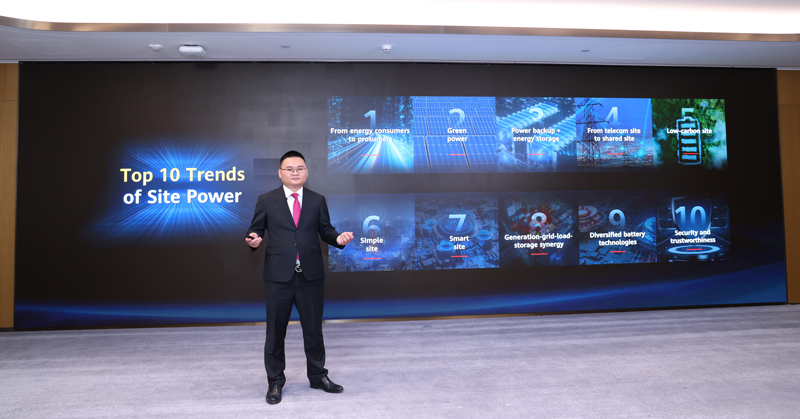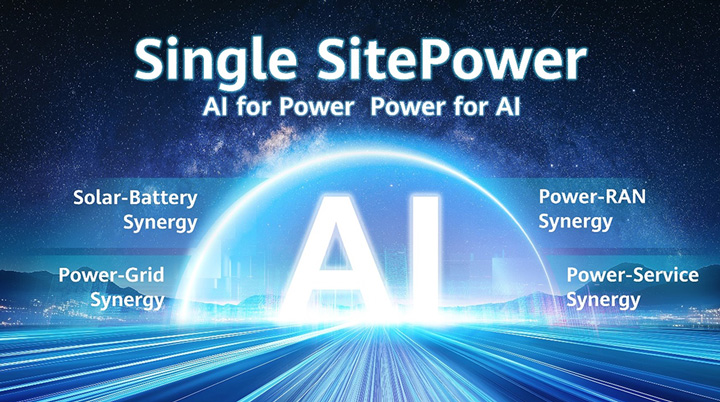[January 19, 2024, Shenzhen, China] Huawei Digital Power released the White Paper on the Top 10 Trends of Site Power 2024. At the release, Li Shaolong, President of Huawei Site Power Facility Domain, gave a comprehensive interpretation of the top 10 trends.
 Li Shaolong, President of Huawei Site Power Facility Domain
Li Shaolong, President of Huawei Site Power Facility Domain
Trend 1: From Energy Consumers to Prosumers
Driven by multiple factors, operators and towercos will not only be energy consumers but also energy producers, and will actively participate in revolutionizing global energy mix and constructing a low-carbon society.
-
As energy consumers: Build green and low-carbon networks to enable network evolution without adding energy operational expenditure (OPEX).
-
As energy producers: Engage in green power production and scheduling (electric power auxiliary services or residential power supply) to reap energy revenues by deploying new energy facilities such as the PV system and energy storage system (ESS).
Trend 2: Green Power
For the telecom energy sector, a standardized green power system will be built from three dimensions: energy self-sufficiency, reasonable benefits, and safety and stability, therefore making the construction and use of green sites a new normal.
-
Energy self-sufficiency: In the context of the reduced cost of green energy (such as solar energy), rising energy expenditure and unstable energy supply due to the energy crisis, and carbon-neutral networks, the construction of green sites helps operators and towercos achieve energy self-sufficiency.
-
Reasonable benefits: The PV system architecture of sites shifts from low-voltage parallel connection to high-voltage serial connection, greatly reducing CAPEX. And by deploying smart optimizers, each PV module is optimized independently, which improves the overall green energy yield, thus generating more financial returns.
-
Safety and reliability: With the introduction of intelligent active safety technologies (such as DC arc detector and arc-fault circuit interrupter) and formulation of relevant standards, the system will be better safeguarded.
Trend 3: Power Backup + Energy Storage
From only power backup to power backup + energy storage. There will be more cyclical applications, such as the peak staggering and the virtual power plant (VPP) services. The telecom VPP energy storage system (referred to as the "VPP system") features simplicity, intelligence, and multi-service convergence.
-
Simplicity: The VPP system adopts a simple self-networking architecture that is decoupled from the existing power supply, enabling operators and towercos to add VPP services smoothly.
-
Intelligence: Equipped with the intelligent collaborative capability featuring extensive, fast, and precise adjustments, the VPP system allows users to engage in electric power auxiliary services.
-
Multi-service convergence: One VPP system integrates multiple services, such as staggering power consumption, demand-side response, and frequency response, facilitating its long-term evolution.
Trend 4: From Telecom Site to Shared Site
In addition to supplying power for communication services, telecom sites can develop diversified services such as "communication + edge computing" or "communication + residential power supply" according to local needs, expanding the service scope of sites. Telecom sites support the eMIMO mode and intelligent collaboration to provide more advanced services.
-
Multi-mode power supply: The power supply transforms from simple AC/DC conversion to multi-mode architecture. One power supply supports multiple energy source inputs and multi-mode outputs.
-
Intelligent collaboration: The power supply should support intelligent collaboration to ensure stable services even in complex scenarios with multiple power inputs and various downstream devices, while continuously optimizing the system for cost-effectiveness and profitability.
Trend 5: Low-Carbon Site
Against the backdrop of the continuous growth in network power consumption, energy crisis, and the emission reduction demand raised by carbon neutrality, global operators and towercos will continue to build low-carbon sites. A refined mode characterized by multiple standards, multiple solutions, and intelligent management is adopted to accelerate the development of low-carbon sites.
-
Multiple standards: Multi-dimensional scientific standards, such as the site energy efficiency (SEE) and network carbon intensity energy (NCle) indicators, are used as the evaluation basis to guide the top-level design of low-carbon networks.
-
Multiple solutions: In addition to approaches like "changing rooms to cabinets and cabinets to poles" to achieve "air conditioner removal and energy efficiency improvement", PV deployment and genset-free hybrid power supply can also help reduce network carbon emissions.
-
Intelligent management: Intelligent site management enables the visualization of energy efficiency and carbon emissions, providing a systematic and targeted approach to energy saving and emission reduction.
Trend 6: Simple Site
Operators continue to build energy networks featuring simple architecture, premium quality, cost-efficiency, and optimal experience, constructing simple sites across multiple dimensions.
-
Simple architecture: Sites are greatly simplified from equipment rooms to cabinets and from cabinets to poles. With the advancing of outdoor blade power supply and blade battery technologies, cabinets at sites are replaced with poles.
-
Premium quality: Blade power supplies and blade batteries are maintenance-free throughout their lifecycles, coupled with the intelligent remote O&M, which helps relieve burdens of maintenance on site power facilities to a great extent.
-
Cost-efficiency: While with low costs of individual components, traditional sites feature high hidden costs, whereas costs in simple sites are reduced from construction to maintenance in an end-to-end manner.
-
Optimal experience: Energy efficiency and carbon emissions are remotely monitored, managed, and optimized. Intelligence delivers efficient management, and efficient management leads to excellent experience.
Trend 7: Smart Site
With the aid of power electronics and digital technologies, the full link of sites from power generation, conversion, storage, distribution, consumption, to management operates on an intelligent basis. By "managing watt with bit", the power supply system enters a smart era.
-
Intelligent generation: Smart optimizers enable intelligent PV power generation at sites. Shading losses are reduced, facilitating power generation; the system is automatically shut down in the case of PV string faults, ensuring safe operations; remote O&M helps relieve burdens of maintenance.
-
Intelligent conversion: The traditional power supply is upgraded to a smart power supply, improving power conversion efficiency.
-
Intelligent storage: Lead-acid batteries and common lithium batteries are upgraded to intelligent lithium batteries, transforming simple power backup into integrated backup + energy storage.
-
Intelligent distribution: Traditional circuit breakers are upgraded to intelligent circuit breakers for more precise power distribution.
-
Intelligent consumption: The power supply is flexibly adjusted based on services of main network devices to achieve refined power consumption.
-
Intelligent management: The intelligent network management system enables the remote monitoring, management, and optimization of energy efficiency and carbon emissions at sites.
Trend 8: Generation-Grid-Load-Storage Synergy
The power supply system, power grid, and load devices of a site are no longer isolated from each other to achieve intelligent generation-grid-load-storage synergy. For example, the intelligent peak shaving function of batteries helps operators expand site capacity without reconstructing the mains, accelerating site deployment; the collaboration of PV and battery technologies help store the surplus PV power, achieving zero energy waste and greater benefits; by engaging in power services including intelligent peak staggering and the VPP, sites can deliver extra energy benefits; the power supply is flexibly adjusted based on services of main network devices to achieve refined power consumption.
Trend 9: Diversified Battery Technologies
Batteries at telecom sites is evolving towards diversification in terms of materials, applications, and management technologies.
-
Materials: Sodium battery materials are more accessible and cost-effective. From lead-acid batteries to lithium batteries and then to sodium batteries, battery materials will be further diversified.
-
Applications: Lead-acid batteries and lithium batteries, due to their material properties, cannot satisfy all application needs of communications networks. With the diversification of battery materials, the application scope of batteries will be further expanded. For example, sodium batteries feature high stability, a wider operating temperature range, and high applicability in low-temperature scenarios. In addition, sodium batteries have a faster charging rate to support extensive cyclic applications in the energy storage system.
-
Management technologies: Energy storage systems are moving from simple parameter management such as state of charge (SOC) and state of health (SOH) towards intelligent management that supports intelligent hybrid use, intelligent anti-theft, intelligent voltage boosting, and VPP access functions.
Trend 10: Security and Trustworthiness
Operators will build secure and trustworthy energy networks centering on device security, network security, security authentication, and trustworthy process and result.
-
Device security: Component security, device usage security, and maintenance safety are required at the device hardware level.
-
Network security: Energy networks must be secured in terms of architecture, data, and defense against attacks.
-
Security authentication: Energy networks must pass various security qualification certifications (such as EU's CE-RED) and comply with security regulations and standards.
-
Trustworthy process and result: Energy networks should incorporate the security and trustworthiness requirement into the product development process, focus on vulnerability management and privacy protection, and ensure that the process and result are secure and trustworthy.
By releasing the top 10 trends of site power in 2024, Huawei Digital Power aims to deliver the benefits of technological innovation and promote the development and prosperity of the industry, as parts of our contributions to the sustainable development and business success of operators and towercos.
For more information, please click the below link. White Paper on the Top 10 Trends of Site Power 2024: https://digitalpower.huawei.com/en/activity/detail/232.html#downloads








